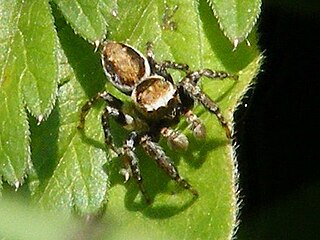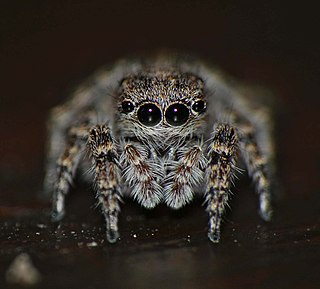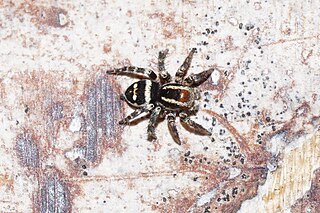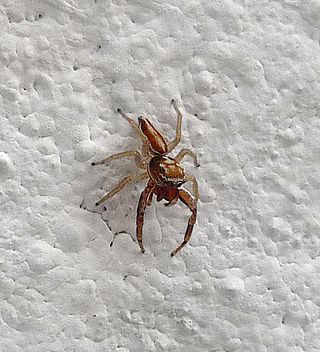
Mexcala formosa is a species of jumping spider in the genus Mexcala that is endemic to Ethiopia. The spider was first defined in 2008 by Wanda Wesołowska and. It mimics ants, living alongside and preying upon them. Only the male has been described. It is a medium-sized spider, with a cephalothorax typically 2.9 mm (0.11 in) long and an abdomen typically 3.5 mm (0.14 in) long. The carapace is dark brown and the eye field black. The spider is similar to the related Mexcala agilis and Mexcala elegans, but can be distinguished by its thinner tibial apophysis and the white scales on its cymbium.

Evarcha awashi is a species of jumping spider in the genus Evarcha that lives in Ethiopia. The species was first described in 2008 by Wanda Wesołowska and Beata Tomasiewicz. The spider is small, with a cephalothorax measuring between 2.0 and 2.3 mm long and an abdomen between 1.9 and 2.4 mm long. The male and female are similar in size but differ slightly externally. The male carapace is orange while the female is brown, both with a darker eye field. The pattern on the abdomen is generally similar, a combination of light background and dark patches, but the female has less contrast between the two. The legs are mainly brown with yellowish tarsi. Its copulatory organs are distinctive. The male has a short embolus that follows the palpal bulb and a sharp tooth on its short wide and blunt protrusion on its palpal tibia, or tibial apophysis. The female has insemination ducts that narrow into multi-chambered spermathecae.

Evarcha rotundibulbis is a species of jumping spider in the genus Evarcha that lives in Ethiopia. The species was first described in 2008 by Wanda Wesołowska and Beata Tomasiewicz. The spider is small to medium-sized, with a cephalothorax measuring between 2.4 and 2.7 mm long and an abdomen between 2.3 and 2.6 mm long. The carapace is light brown with a dark brown eye field. The abdomen is russet with a yellowish pattern of arrows and spots. The spider has brown and yellow legs. Its copulatory organs are unusual and help identify it. The male has a distinctive rounded palpal bulb that is recalled in the name of the species. It also has a very short forked embolus and a shovel-like projection, or apophysis, on the palpal tibia that distinguishes it from other related species. The female has not been described.

Evarcha russellsmithi is a species of jumping spider in the genus Evarcha that lives in Ethiopia. The species was first described in 2008 by Wanda Wesołowska and Beata Tomasiewicz. The spider is small to medium-sized, with a cephalothorax measuring typically 2.2 mm (0.09 in) long and an abdomen 1.8 mm (0.07 in) long. The carapace is yellowish with dark rings around the spider's eyes. The abdomen is brown with an indistinct pattern of spots and lines. The legs are generally brown. The copulatory organs are distinctive. The male has a projection, or apophysis, from the palpal tibia that is has a series of tooth-like features, and a very short embolus that is attached to another very small apophysis. The female has multi-chambered spermathecae and distinctive accessory glands.

Evarcha bakorensis is a species of jumping spider in the genus Evarcha that lives in Guinea, Ivory Coast and Nigeria. It thrives in savanna grasslands. The species was first described in 2002 by Christine Rollard and Wanda Wesołowska. The spider is small, with a cephalothorax measuring between 1.6 and 1.8 mm long and an abdomen that is between 1.3 and 1.9 mm long. The female is larger than the male. The cephalothorax has a light brown topside, or carapace, yellow underside, or sternum, and darker sides. The abdomen is greyish-brown or brown and has a lighter pattern on it. The spider has generally brown legs. It has distinctive copulatory organs. The female has a large membrane in the centre of its epigyne while the male has a straight and blunt tibial apophysis, or projection on its palpal tibia.

Euophrys kawkaban is a species of jumping spider in the genus Euophrys that is endemic to Yemen. The species was first described in 2007 by Wanda Wesołowska and Antonius van Harten. It is a very small spider, with a body that consists of a carapace, the hard upper part of the cephalothorax, that is typically 1.7 mm (0.07 in) long and 1.3 mm (0.05 in) wide and an abdomen that is typically 1.5 mm (0.06 in) long and 1.1 mm (0.04 in) wide. The carapace is yellowish, marked with a pattern of brown wedges, with a dark brown eye field. The underside of the cephalothorax, or sternum, is yellowish-brown. The abdomen has a pattern of yellowish-white and brownish-black spots that, at times, look like a series of waves. The spider's clypeus is unusual, being yellowish-brown with a covering of white hairs, which clearly differentiates the species from the related Euophrys flavoater. The male's copulatory organs, including its long and thin embolus, also helps distinguish the species. The female has not been described.
Afrobeata magnifica is a species of jumping spider in the genus Afrobeata that lives in Tanzania. The species was first described in 2000 by Wanda Wesołowska and Anthony Russell-Smith. The spider has an olive-green carapace measuring between typically 2.8 mm (0.11 in) long and a brown abdomen 2.9 mm (0.11 in) long. The male has a pattern of two large light diagonal stripes on its abdomen. The front legs of the male are longer than the rest. The copulatory organs are distinctive.. The male has a characteristically small palpal femur and a small appendage on its palpal tibia, or tibial apophysis that has two sections, one blunt and the other sharp. The female has not been described.

Plexippus lutescens is a species of jumping spider in the genus Plexippus that lives in Namibia and Zimbabwe. It was first described in 2002 by Wanda Wesołowska. Only the male has been described. In 2017, Jerzy Prószyński declared it should be reclassified as the spider has a different palpal bulb to others in the genus, but this was not undertaken. It is a medium-sized spider, with a cephalothorax typically 3.3 mm (0.13 in) long and an abdomen that is 4 mm (0.16 in) long. The dark brown carapace has three white stripes and the reddish-brown abdomen has a single stripe of lighter brown. The spider has a short tibial apophysis and thin embolus. It lacks the lateral lobe on the palpal bulb that is visible on other species in the genus.

Langelurillus manifestus is a species of jumping spider in the genus Langelurillus that lives in Tanzania. It was first described in 2000 by Wanda Wesołowska and Anthony Russell-Smith. The spider is small, with a carapace that is between 2.1 and 2.5 mm long and an abdomen between 2.0 and 2.2 mm long. The female carapace is lighter than the male and has a pattern of irregular patches, which may also be found in some examples of the female abdomen. The male abdomen is lighter and has a fawn streak down the middle. The legs are brown, the female having dark rings on its legs. It is similar to other related species, particularly Langelurillus rufus, but can be distinguished by the male's larger size and lighter coloration. The female has an oval epigyne that leads to seminal ducts that are shorter than Langelurillus rufus but longer than Langelurillus squamiger.

Langelurillus minutus is a species of jumping spider in the genus Langelurillus that lives in Namibia and Zimbabwe. It was first described in 2011 by Wanda Wesołowska and Meg Cumming. The spider is small, with a cephalothorax that is between 1.8 and 2.3 mm long and an abdomen between 1.5 and 3.9 mm long. The male is noticeably smaller than the female, which is reflected in the species name. The species is generally brown, but has indistinct patches on its abdomen and orange or orange-yellow legs. The male has a very convex palpal bulb and the female an epigyne with a large pocket and compact multi-chambered receptacles.

Langelurillus quadrimaculatus is a species of jumping spider in the genus Langelurillus that lives in Nigeria. It was first described in 2011 by Wanda Wesołowska and Anthony Russell-Smith. The spider is small, with a cephalothorax that is between 1.7 and 2.5 mm long and an abdomen between 2.0 and 2.2 mm long. The female is larger than the male. It can be distinguished from other species in the genus by its abdominal pattern, which is recalled in the species name, that consists of two pairs of rounded yellow patches on a brownish-grey background. The female also has a distinctive internal layout of its seminal ducts within its short and wide epigyne.

Euophrys nana is a species of jumping spider in the genus Euophrys that is endemic to South Africa. The species was first described in 2014 by Wanda Wesołowska, Galina Azarkina and Anthony Russell-Smith. It is a small spider, with a body that consists of a cephalothorax that is typically 1 mm (0.04 in) long and an abdomen that is typically 1.5 mm (0.06 in) long. The carapace, the topside of the cephalothorax is brown a central yellow stripe. The underside of the cephalothorax, or sternum, is yellowish-brown. The abdomen has a distinctive pattern of brown and white stripes around its entire body. It is this pattern that differentiates the spider from related species. The copulatory organs are also unique amongst spiders in the genus, particularly the very long thin embolus on the palpal bulb of the male. The female has not been described.

Euophrys miranda is a species of jumping spider in the genus Euophrys that is endemic to South Africa. The species was first described in 2014 by Wanda Wesołowska, Galina Azarkina and Anthony Russell-Smith. Only the female has been described. It is a very small spider, with a body that consists of a cephalothorax that is typically 1.6 mm (0.06 in) long and an abdomen that is typically 1.4 mm (0.06 in) long. The carapace, the topside of the cephalothorax is dark brown with an even darker eye field. The underside of the cephalothorax, or sternum, is brown. The topside of the abdomen is duller than the carapace and has a pattern of dark and light wavy lines. The underside of the abdomen has four lines of light dots. Its copulatory organs are unique amongst spiders in the genus, particularly its very small receptacles, or spermathecae, and the complex pattern that the very narrow insemination ducts make. This complexity is the reason for the species name, which can be translated "curious".
Yimbulunga foordi is the type species of the genus Yimbulunga. It is a species of jumping spider species that lives in South Africa. The male was described in 2014 by Wanda Wesołowska, Galina Azarkina and Anthony Russell-Smith. The female has not been identified. The spider is very small, with a carapace that is 1.8 mm (0.071 in) long and an abdomen 1.4 mm (0.055 in) long. Both the carapace and abdomen are rounded, which is reflected in the genus name, the Zulu word for spherical. The species is named for the arachnologist Stefan Foord. The pedipalps are brown with a small lobe on the palpal bulb and a thin embolus that coils all the way round. The shape of the embolus and the overall stout shape of the spider differentiate the species.

Stenaelurillus pilosus is a species of jumping spider in the genus Stenaelurillus that is endemic to Nigeria. It was first described in 2011 by Wanda Wesołowska and Anthony Russell-Smith. The spider is medium-sized, with a brown carapace between 2.6 and 2.8 mm in length and an abdomen between 2.3 and 3.6 mm in length. It can be distinguished from other species in the genus by the dark brown band on its clypeus, the distinctive long orangish-brown hairs on its black eye field, the male's straight embolus and the presence of two fissure-like openings in the epigyne on the female.

Phintella occidentalis is a species of jumping spider in the subfamily Salticinae that lives in Ivory Coast. First described by Wanda Wesołowska and Anthony Russell-Smith in 2022, the species is named after the Latin word for western as it is found in West Africa. The spider is small, with a cephalothorax between 2.3 and 2.8 mm long and an abdomen that is between 3.1 and 3.5 mm long. The female is smaller than the male. The carapace is brown, the female light and the male dark. The abdomen is yellow and is marked by two wide brown stripes on the female and a grey streak on the male. It is the abdominal pattern that most clearly distinguishes the species from others in the genus. The copulatory organs are also different. The male has a longer tibial apophysis, or appendage and the female has seminal ducts that diverge and then converge.

Phintella transversa is a species of jumping spider in the genus Phintella that lives in Ivory Coast. First described by Wanda Wesołowska and Anthony Russell-Smith in 2022, only the male has been identified. The spider is small, with a cephalothorax between 2.0 and 2.4 mm long and an abdomen that is between 2.1 and 2.4 mm long. The carapace is dark brown and the abdomen is brownish-black and marked with four light, nearly white streaks. It is that abdominal pattern that most clearly distinguishes the species from others in the genus and is recalled in the species name. The copulatory organs are also distinctive. The palpal bulb has a small triangular lobe on the back and a curved addition near the small embolus.

Phintella brevis is a species of jumping spider in the genus Phintella that lives in Ivory Coast. First described by Wanda Wesołowska and Anthony Russell-Smith in 2022, the spider is small, with a cephalothorax between 2.0 and 2.1 mm long and an abdomen between 1.9 and 2.0 mm long. Only the female has been described. The carapace is brown and the abdomen yellow. Although similar to the related Phintella lucida, the copulatory organs are distinctive, particular the tip of the spike on the tibia, the tibial apophysis.

Icius bandama is a species of jumping spider in the genus Icius that lives in Ivory Coast. It was first described in 2022 by Wanda Wesołowska and Anthony Russell-Smith.. The spider lives communally amongst other spiders and preys on insects. It is small, with a cephalothorax between 2.0 and 2.1 mm long and an abdomen 2.0 and 3.0 mm long. The female and male carapace are similar in size and colouration. The male abdomen is greyish-beige and marked with a light streak and two stripes. The female has a yellowish-olive abdomen broken by a white band on the forward edge. The species is similar to other Icius spiders but differs in the shape of the tibial apophysis, or spike, on the male and the lack of a pocket on the epigynal and internal structure of the copulatory organs of the female.

Langona recta is a species of jumping spider in the genus Langona that lives in Ivory Coast. It was first described in 2022 by Wanda Wesołowska and Anthony Russell-Smith. Only the male has been identified. The spider is medium-sized, with a cephalothorax that is typically 4.0 mm (0.16 in) long and an abdomen between 3.0 and 3.5 mm long. It is hairy and brown, the abdomen lighter than the carapace with a hint of a white streak visible on the back. It has the toothless chelicerae typical of the genus, but, unlike other Langona spiders, has a straight palpal apophysis, or spike, reflected in the species name.














